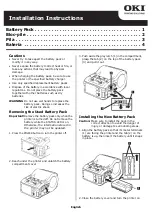
Chapter 7
Page 175
Network preferences and TCP/IP software
The Network Preferences settings enable you to use the TCP/IP
software that is included in the organizer operating system. You can
use the TCP/IP software to connect with Internet Service Providers
(ISPs) or dial-in (remote access) servers. Because the TCP/IP software
is a feature of the operating system, you configure all parameters
relating to it from the Preferences application.
To use TCP/IP, you must create a configuration in Connection
Preferences and then create Network Preferences settings.
Note: The Connection Preferences screen enables you to define
several ways that your organizer can use the modem to
communicate with remote devices. For example, you can
communicate with your ISP server, or with your computer if
you are away on travel. See “Connection preferences” earlier
in this chapter for a complete explanation on how to create
modem configurations.
After you configure both the Connection and Network Preferences,
you can establish a PPP (Point-to-Point Protocol), SLIP (Serial Line
Internet Protocol), or CSLIP (Compressed Serial Line Internet
Protocol) connection with your ISP or dial-in server. You can do this
either by using menu commands from the Network Preferences
screen or by using a third-party application.
Note: TCP/IP provides the ability to connect to your ISP or dial-in
server with applications that allow you to view the
transmitted data. Visit the web site http://www.palm.com for
information on third-party applications that take advantage of
TCP/IP.
Selecting a service
Use the Service setting to select the service template for your Internet
Service Provider or a dial-in server. Service templates are a set of ISP
and dial-in server configuration settings that you can create, save, and
reuse.
Summary of Contents for IIIc
Page 1: ...Handbook for the Palm IIIc Organizer ...
Page 8: ...Page viii Handbook for the Palm IIIc Organizer ...
Page 10: ...Page 2 About This Book ...
Page 34: ...Page 26 Introduction to Your Palm IIIc Organizer ...
Page 122: ...Page 114 Using Your Basic Applications ...
Page 150: ...Page 142 Communicating Using Your Organizer ...
Page 172: ...Page 164 Advanced HotSync Operations ...
Page 200: ...Page 192 Setting Preferences for Your Organizer ...
Page 206: ...Page 198 Maintaining Your Organizer ...
Page 236: ...Page 228 ...
















































